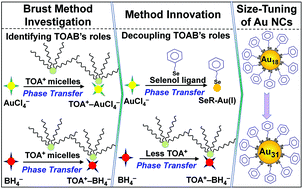From understanding the roles of tetraoctylammonium bromide in the two-phase Brust–Schiffrin method to tuning the size of gold nanoclusters†
Abstract
The two-phase Brust–Schiffrin (B–S) method has been widely used for synthesizing small-sized Au nanoparticles (NPs) of size 2–6 nm, as well as Au nanoclusters (NCs) of size <2 nm. However, size tuning of Au NCs at the atomic level by this method is challenging probably due to a lack of in-depth understanding of its mechanism. Herein, we report the identification of two roles of tetraoctylammonium bromide (TOAB) in the two-phase B–S method: TOAB not only transfers Au(III) precursors but also transfers the reducing agent NaBH4 from the aqueous to the organic phase. On this basis, we developed a novel two-phase synthetic strategy by decoupling the roles of the TOAB: (1) using the hydrophobic selenolate ligand to transfer Au(III) precursors from the aqueous to the organic phase via the formation of selenolate–Au(I) complexes and (2) deploying a small amount of TOAB as “shuttles” to transfer NaBH4 into the organic phase for controlled reduction of selenolate–Au(I) complexes in organic phase. Using this strategy, size tuning of Au NCs at the atomic level could be achieved by simply varying the amount of TOAB. The high yields of Au NCs (≥76%) together with the short synthetic time (≤3 h) and size-tuning capability further illustrate the attractiveness of this synthetic strategy. These advantages also present the classical B–S method with greater strength and flexibility towards NC synthesis.



 Please wait while we load your content...
Please wait while we load your content...